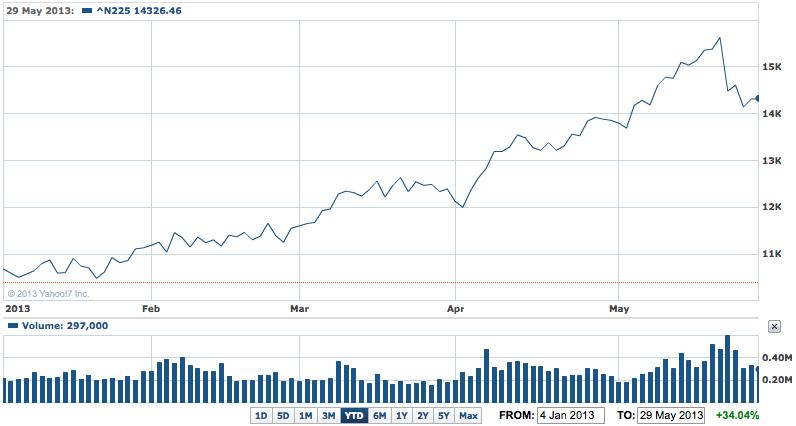Should we start fearing Thursday trading on the Tokyo stock market?
A week ago the market fell sharply – swinging from a 2% gain to a loss of 7.3% at the close. Yesterday it fell more than 5% and it’s now officially in correction territory.
In fact it was a week ago Wednesday that the Nikkei was at a five and a half year high, having risen 75% since last November on expectations the spending spree from the government and the country’s central bank could drag the economy out of its deflationary, low growth rut.
Yesterday, it suddenly slid in afternoon trade, plunging 5.2% to close under the 14,000 point level for the Nikkei for the first time in a month. It was a replay of the previous Thursday and started markets sliding across the region.
But that’s as far as it went and European and US markets finished higher.
Tokyo’s fall followed a weak day on Wall Street as more economic data suggest the US economy was improving and that this could see an earlier than expected slowing in the rate of easing from the Federal Reserve.
It now seems that the big rally that started last November has come to an end and the market is now correcting.
Nikkei YTD – Japanese market enters correction

In fact, the Tokyo market is down 13% since those highs on Wednesday of last week as investors seem to be signalling that the rally has gnome as fast as it can for the time being.
For investors in Australia it seems Tokyo’s moves are impacting our market, on top of the usual leads we take from the US (and China is it was to fall sharply). That’s a big change after years of no impact at all.
But it seems the influence is negative, not positive – we haven’t followed the Tokyo market higher, for instance.
Yesterday’s fall came on an about turn in the forex market where the yen rose sharply against the US dollar and other currencies. That helped gold rise sharply, but it lost ground, then bounced as the US dollar fell after America produced more solid economic news. Oddly oil prices fell for a while as the US dollar fell!
Our market lost 0.9% or 44 points on the ASX 200 index which ended at 4930.7, the lowest since April 19. The All Ords was down 42 points.
Hong Kong’s Hang Seng Index dropped 0.4% and the Shanghai Composite Index eased 0.2%. Taiwan’s Taiex dropped 1.1%, Singapore fell 0.9% and South Korea’s Kospi eased 0.1% (South Korean exports improved in May after a near 3% drop in April).
Tokyo started falling soon after lunch and the tremors rolled across the region with our market off 1.3% at one stage.
Not helping was another fall in world iron ore prices which dipped to just under $US113 a tonne, a seven month low and well under the 2013 peak of around $US158 in February.
As a result miners BHP Billiton and Rio Tinto, which lost 1.2% and 1.4%. Fortescue Metals shed more than 6%.
Financials stocks were also weaker, with NAB tumbling 4% its lowest point since February after trading ex-dividend A not unexpected fall). ANZ slipped 0.3%.
But Westpac rose 0.5% and the CBA was up 1% (72 cents) in a surprisingly strong showing.













